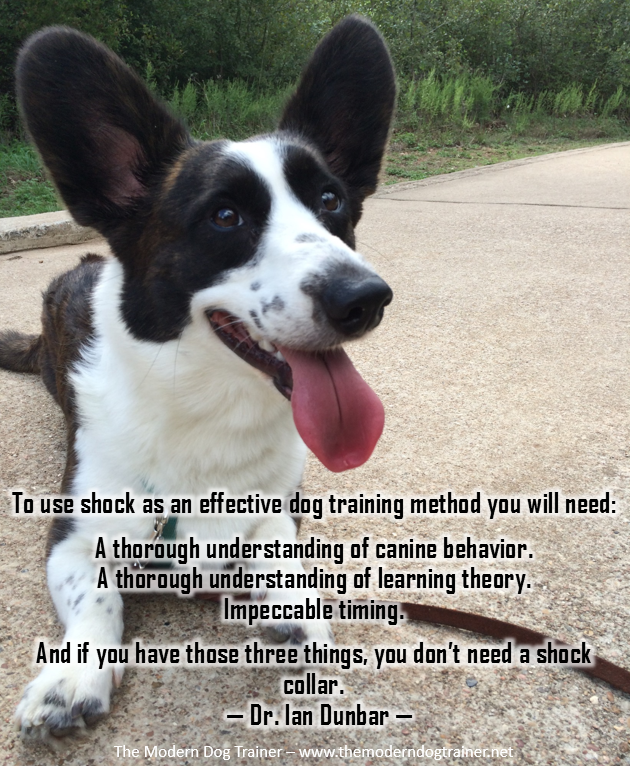The Truth About Shock Collars: There Shouldn’t Be A Trade Off Between Welfare And Better Behavior
A recent article was published that discusses the humane-ness of using shock collars to train dogs. The Science of Dog Training: Is It Okay To Use A Shock Collar? discusses the research behind the conclusion that shock or ecollars as training aids are as effective as positive reinforcement methods alone which makes their use utterly unnecessary.
Remote Electronic Training Collars (RETC). They were on a mission to reveal:
- whether shock collars used to train household pets were effective, and
- what were the associated welfare consequences.
Cooper and his team paid very close attention to some of the common variables in dog training. Their experiment set up broke down the dogs into three groups. Group A was trained using a shock collar by an experienced, Electronic Collar Manufacturers Association (ECMA) nominated professional trainer, Group B was trained by the same trainer and wore an inactive shock collar, and Group C worked with the Association of Pet Dog Trainers (an anti-electronic collar group) nominated professional dog trainer. The inactive shock collars in Group B prevented observers from telling which group they belonged to. All groups utilized positive reinforcement to acknowledge appropriate behavior.
Results
No matter the method, over 91% of owners were thrilled with the results that the training had on their dogs. Surprisingly, physiological urinary stress hormones were at similar levels throughout the groups and showed no significant changes. Group C showed higher levels of salivary cortisol than Groups A and B which was unexpected, but compared to the before and after training cortisol levels, none of the groups showed significant changes.
It was observed that Groups A and B displayed more stress-related behaviors and winced from sudden movement more often than Group C did with their trainers. This was perhaps due to the trainer’s style or personality rather than due to the active or inactive shock collars they were wearing.
More important than the method trainers teach to owners is owner compliance. Without owner compliance, no method will be successful. Surprisingly, only 76% of the owners in Group A were willing to continue the training compared to 95-100% of owners from Group B and C. Group A’s lack of confidence demonstrates an average dog owner’s discomfort with using this kind of collar.
“These findings suggest that there is no consistent benefit to be gained from e-collar training but greater welfare concerns compared with positive reward based training” says Cooper.
Future Study Recommendations
This study, just like many, is limited to the techniques the trainers used. Dog training is as much an art as it is a science. While some trainers may believe in the same science behind a method and use the same tools, their application can be completely different. Trainer’s skills and approaches vary greatly and this study was limited to four trainers. A larger number of trainers from a variety of demographics is needed to draw stronger conclusions. Of course, this is usually limited due to funding, time, and resources.
In the future, we would love to see salivary cortisol samples taken more often than just before and after training. Group C displayed higher levels than the other groups which was very interesting. We would like to know the group’s salivary cortisol levels just before receiving their normal meals, during praise-only or play-only training interactions, and how food (as well as the differences between types of food) affect salivary cortisol levels.
Based on the research that is currently accessible, this study is monumental in spreading the truth about shock collars. Their effect on a dog’s mental well-being should not be ignored.
We would like to conclude by leaving this quote for you to ponder. Share your response to this research in the comments below or on our Facebook page.





even though I agree that in the vast majority of training an e-collar is not necesary/not my first choice and most people should keep away from them, some activities can be difficult to manage.
I am partucularly thinking of highly arousing activities with a high degree of self reinforcement for the dog meaning the dog is self-rewarding by the unwanted act/ behaviour itself.
Protection training is such an activity. Let’s say a dog is not outing simply because he enjoys the activity of biting so much and is (too?) highly aroused/ full of adrenaline while under other circumstances with less stimulation the dog outs without problems; he knows the command, he has shown he understands what is meant by it but he “chooses” (by lack of a better term) not to because he likes the act of biting so much.
Note this is just a hypothetical situation and would be applicable to any highly arousing and self reinforcing activity (sheep or car chasing, fence fighting etc).
Point is, what if the activity itself is super rewarding and it would be very hard to come up with a positive alternative which would top that
My questions:
How would you solve this problem without some form of correction and would the e-collar be an alternative in these situations?
Are there protection dog trainers out there who train totally without any aversives?
just wondering…..
Hi Tom, Check out Shade Whitesel. She does IPO with her dogs at a high level and doesn’t need to use e-collars to do it. http://shadesdogtraining.net
Also check out Steve White who trains Police dogs. http://www.proactivek9.com
There are many more out there who do this! They are leading the way!